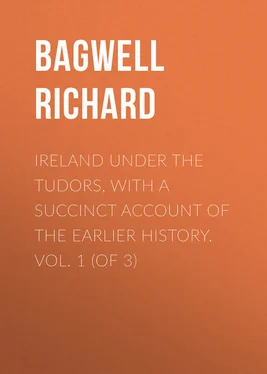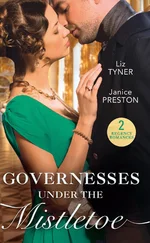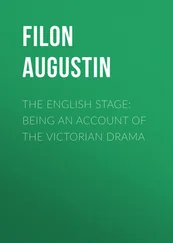Richard Bagwell - Ireland under the Tudors, with a Succinct Account of the Earlier History. Vol. 1 (of 3)
Здесь есть возможность читать онлайн «Richard Bagwell - Ireland under the Tudors, with a Succinct Account of the Earlier History. Vol. 1 (of 3)» — ознакомительный отрывок электронной книги совершенно бесплатно, а после прочтения отрывка купить полную версию. В некоторых случаях можно слушать аудио, скачать через торрент в формате fb2 и присутствует краткое содержание. Жанр: foreign_antique, foreign_prose, Историческая проза, на английском языке. Описание произведения, (предисловие) а так же отзывы посетителей доступны на портале библиотеки ЛибКат.
- Название:Ireland under the Tudors, with a Succinct Account of the Earlier History. Vol. 1 (of 3)
- Автор:
- Жанр:
- Год:неизвестен
- ISBN:нет данных
- Рейтинг книги:4 / 5. Голосов: 1
-
Избранное:Добавить в избранное
- Отзывы:
-
Ваша оценка:
- 80
- 1
- 2
- 3
- 4
- 5
Ireland under the Tudors, with a Succinct Account of the Earlier History. Vol. 1 (of 3): краткое содержание, описание и аннотация
Предлагаем к чтению аннотацию, описание, краткое содержание или предисловие (зависит от того, что написал сам автор книги «Ireland under the Tudors, with a Succinct Account of the Earlier History. Vol. 1 (of 3)»). Если вы не нашли необходимую информацию о книге — напишите в комментариях, мы постараемся отыскать её.
Ireland under the Tudors, with a Succinct Account of the Earlier History. Vol. 1 (of 3) — читать онлайн ознакомительный отрывок
Ниже представлен текст книги, разбитый по страницам. Система сохранения места последней прочитанной страницы, позволяет с удобством читать онлайн бесплатно книгу «Ireland under the Tudors, with a Succinct Account of the Earlier History. Vol. 1 (of 3)», без необходимости каждый раз заново искать на чём Вы остановились. Поставьте закладку, и сможете в любой момент перейти на страницу, на которой закончили чтение.
Интервал:
Закладка:
In the moment of victory Brian was left behind, and Brodir, who had lingered for a time in a thicket, broke through the line of shields and hewed off the king’s head. The Viking was taken and disembowelled alive, according to the Norse account, but the Irish writers say that he fell by Brian’s hands. Sigurd being already dead, Gormflaith lost all chance of a royal husband, and it is only further recorded of her that she died sixteen years later. Many other chiefs fell, including Maelmordha, and Murrough, Brian’s favourite son, and the fight was followed, as it had been heralded, by many signs and wonders both in the Celtic and in the Scandinavian world.
The popular delusion that the battle of Clontarf caused the expulsion of the Danes from Ireland must be pretty well dissipated by this time. Sitric remained with reserves within the fortress, and thus saved his kingdom; nor do the annalists cease to make frequent mention of the foreigners. But the defeat was great, and may have had considerable influence in deciding those who were already hovering between Woden and Jesus. Fourteen years after Clontarf we find Sitric going to Rome, and his son Olaf was killed in England when attempting the same pilgrimage. These facts lend some countenance to the legend that Sitric founded Christ Church in 1038; for the Roman court well knew how to impress the rude northern warriors, and to profit in various ways by their simple faith. We are told that Flosi the Icelander went to Rome to cleanse himself from the stain of blood-guiltiness, ‘where,’ says the Njal-Saga, ‘he gat so great honour that he took absolution from the Pope himself, and for that he gave a great sum of money.’
Without actually amalgamating, the Danes seem to have drawn gradually closer to the native Irish. A royal heir of Ulster received the name of Ragnal less than half a century after Clontarf, and in 1121 a bishop seems to have been temporarily appointed at Dublin by the joint election of Irish and Danes. But quarrels were frequent even after the Danes had become fully Christianised; and when the men of Munster invaded Fingal in 1133, they burned the church of Lusk when it was full of people and treasures. Nor did fresh invasions quite cease, for Magnus, King of Norway, made two expeditions to Ireland, in the latter of which, in 1103, he lost his life. The separate history of the Irish Ostmen was drawing to a close, even at the date of the Anglo-Norman invasion; but they have left indelible traces upon the map of Ireland and on the traditional lore of her people.
Giraldus informs us that the Scandinavians who settled at Dublin, Waterford, and Limerick, came under pretence of peaceful trading. The Irish, he says, were prevented by their innate sloth from going down to the sea in ships, but were ready to welcome those who would trade for them, and thus allowed the fierce strangers to get a strong footing. However this may be, it is certain that the Irish are deficient in maritime enterprise, and equally certain that the Northmen had a constant eye to trade as well as to war and plunder. Unerring instinct pointed out the best stations, and on the sites thus chosen the chief cities of Ireland were reared. The Kaupmannaeyjar or merchant isles, probably those now called the Copelands, may have been a rendezvous for passing vessels. Arabic coins, of which more than 20,000 pieces from more than 1,000 different dies are preserved at Stockholm, have been found in Ireland, and the Irish Northmen certainly had a coinage of their own, when the native princes had none. Pieces have been found which were struck by, or at least for, a Scandinavian king of Dublin as early as the ninth century, and all coins minted in Ireland up to the Anglo-Norman invasion were perhaps of similar origin. Many such pieces have been found in the Isle of Man, and some as far off as Denmark. 24
The Irish annalists constantly dwell on the superiority of Norse arms and armour as a reason for their success in war. Ringmail in particular shows a high degree of manufacturing skill, and they wore it at Clontarf both in brass and iron, while none is mentioned in the pompous Irish catalogue of the arms worn by Brian’s troops. Nor was this costly harness worn only by the Scandinavian leaders, for they are said to have had 1,000 coats of mail in that one battle. Danish swords which have survived from Brian’s days are of superior workmanship to Irish blades of the same date; and the Northmen had perhaps a superiority in bows also, though on this point the annalists are less explicit. The turgid verbosity of these writers makes it doubtful whether the Danes used poisoned arrows, but no such thing is mentioned in the Saga.
The flotillas which Brian maintained on inland waters, and the sea-going vessels which attended his army in the North, were all manned by Danes, and a mercantile marine has in every age been the best nursery of naval power. No doubt the Irish felt the advantage of having commercial emporiums on their coast, as other shore-going people profited by Greek and Phœnician colonies. The analogy might easily be carried further, and Dublin and Waterford might be represented as standing between the Anglo-Normans and Celts of Ireland, as Massilia stood between the Romans and Celts of Gaul. It is at all events clear that the Scandinavians built the first cities and coined the first money in Ireland.
High as Brian towers above other mediæval Celts – one annalist calls him the Charlemagne of North-western Europe – it cannot be said that he laid the foundation of an Irish monarchy. He lived to be eighty, yet none of his work lasted. Malachi received the honorary office of chief king, from which his rival’s personal prowess had driven him, and the years of his reign are counted by some annalists without noticing Brian’s intervention, as in the modern case of Charles II. Brian was indeed doubly a usurper, in wresting Munster from the race of Eoghan, and in wresting Ireland from the race of Nial, in whom royalty had been vested for centuries. With all his ceaseless exertions he was little more than a levier of black mail, who left intact the internal government of weaker princes. Borumha, or the tribute-taker, if that be really the meaning of the term, describes his position with sufficient accuracy. When he died Donnchadh, or Donogh, his son by Gormflaith, became head of his tribe, and claimed the succession to the Irish monarchy. The Eugenians repudiated his claim, alleging that their turn, which had been wrongfully passed over, had now come to reign in Munster. Not satisfied with this, their two principal chiefs fell out among themselves. The Ossorian followed suit, and thus Brian’s creation crumbled at once into dust.
More than 150 years elapsed between the battle of Clontarf and the landing of the first Anglo-Norman, and they were years of almost constant war and confusion. Had Ireland been left to herself a prince might in time have arisen strong enough to establish such a monarchy as Brian failed to found. The Danes had ceased to be a seriously disturbing influence, but there is no evidence that any such process of consolidation was going on, and a feudal system, which had lost none of its vigour, was at last confronted with a tribal system which had lost none of its inherent weakness.
It is impossible to fix the exact date when Christianity began to make head against the Irish Ostmen. When St. Anschar obtained from the Swedes a place for his God in the northern pantheon, and when Guthrum and his officers submitted to baptism in Wessex, a foundation had been laid for a general Scandinavian conversion. But neither Norway nor the Norwegian colonies in Iceland, Shetland, Orkney, or the Hebrides, yielded so soon. Irish anchorites spent some time in Iceland about 795, and when Ingulf and Lief landed in 870 they found that Irish priests had lately been there, and had left behind them books, bells, and croziers. The second batch had probably fled from Ingulf’s congeners in Ireland. Olaf Trygvesson, the first Christian king of Norway, was educated at Athelstane’s court, and the nominal conversion of Norway may date from the year of his accession. Five years later, in 1000, Christianity was established by law in Iceland. Removed as she was from English or Roman influences, Ireland remained a stronghold of paganism after the Danes of England had been generally converted; and the Irish being on the whole weaker in war, were scarcely in a position to prove that Woden and Thor had nothing to say for themselves. Olaf Cuaran was baptized in England. It is clear that the Irish Danes remained generally pagan throughout the tenth century, and that the confederacy which failed at Clontarf had to a great extent been formed against Christianity. The story of Ospak and Brodir shows that some of the fiercest Danes were beginning to waver, the question at issue being the relative power of two deities, rather than the relative merit of two systems. After Clontarf Woden seems to have been looked upon as beaten. He had been tried and found wanting, like Baal on Mount Carmel, and the defeated party went over to the stronger side.
Читать дальшеИнтервал:
Закладка:
Похожие книги на «Ireland under the Tudors, with a Succinct Account of the Earlier History. Vol. 1 (of 3)»
Представляем Вашему вниманию похожие книги на «Ireland under the Tudors, with a Succinct Account of the Earlier History. Vol. 1 (of 3)» списком для выбора. Мы отобрали схожую по названию и смыслу литературу в надежде предоставить читателям больше вариантов отыскать новые, интересные, ещё непрочитанные произведения.
Обсуждение, отзывы о книге «Ireland under the Tudors, with a Succinct Account of the Earlier History. Vol. 1 (of 3)» и просто собственные мнения читателей. Оставьте ваши комментарии, напишите, что Вы думаете о произведении, его смысле или главных героях. Укажите что конкретно понравилось, а что нет, и почему Вы так считаете.












